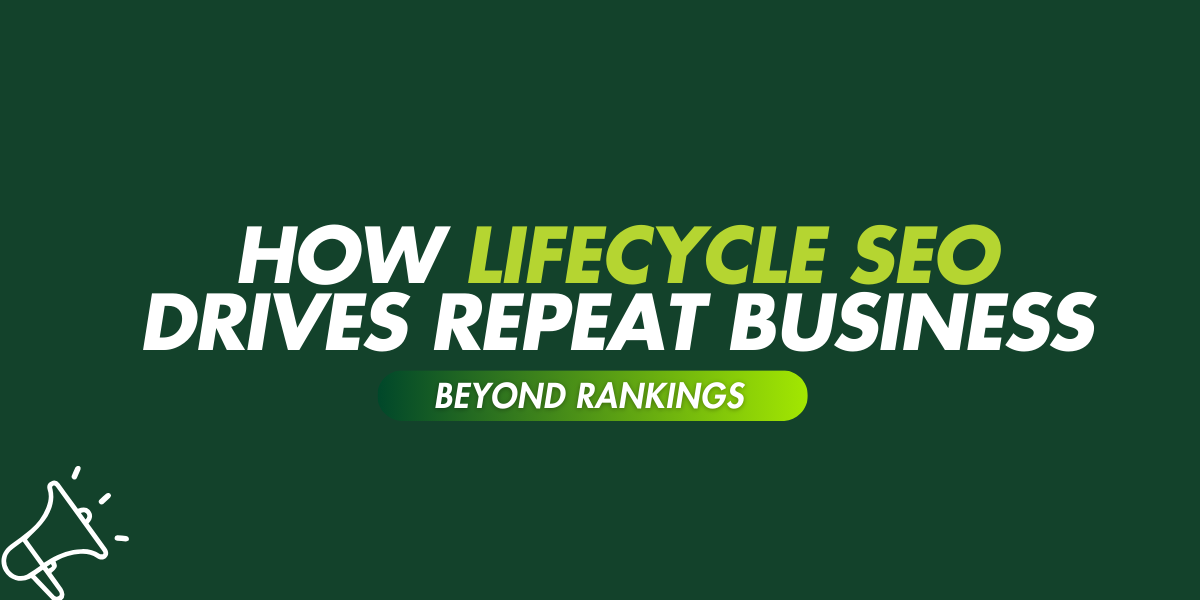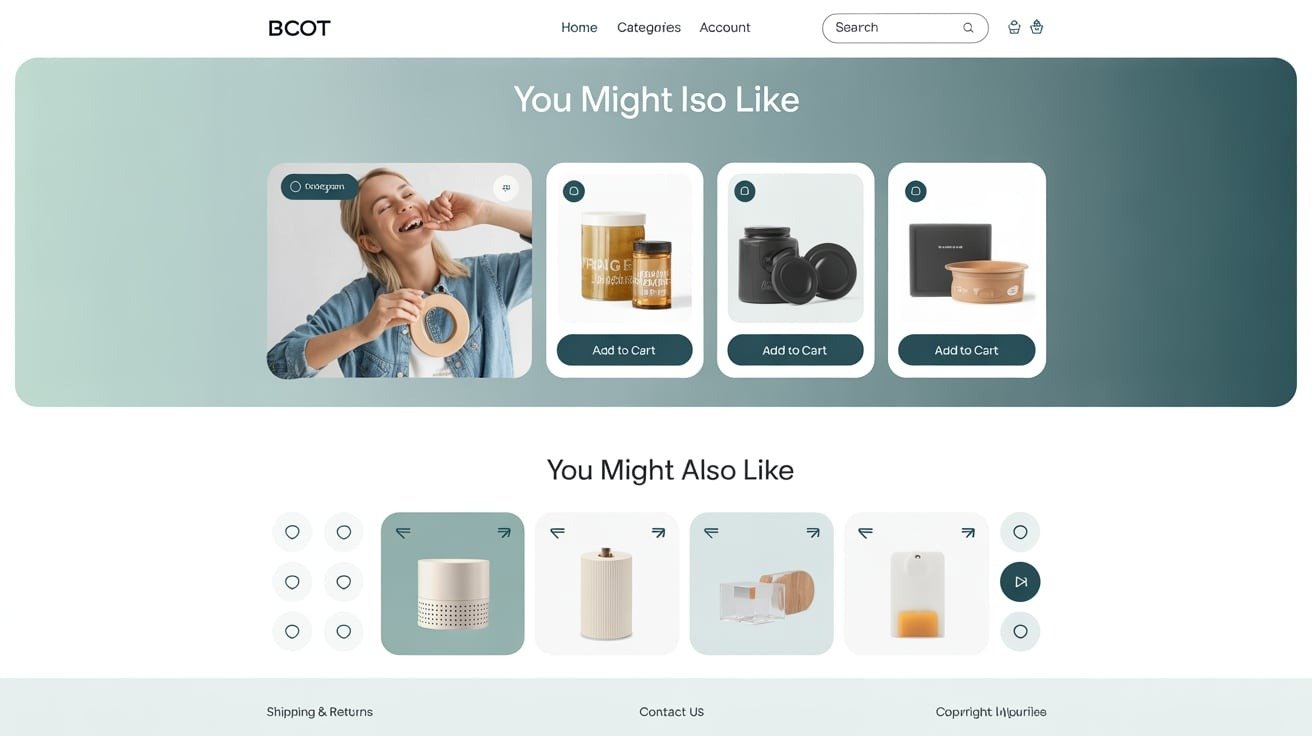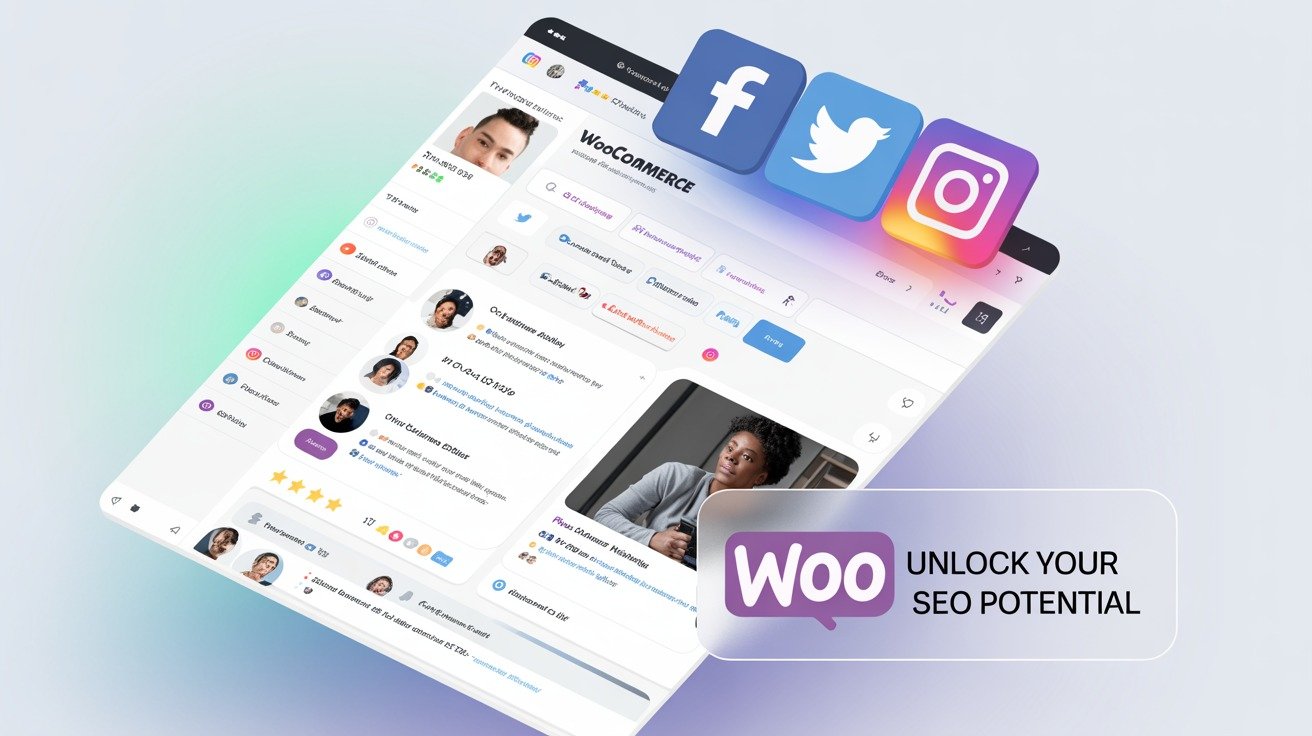
Introduction:
Have you ever thought about why some businesses attract and retain customers and why others are trying hard to get noticed online? It is not just about getting to the top of the search engine rankings or writing a perfect blog. There is more to social buttons than what meets the eye, they have an underlying factor that makes people stick around for more.
That something is called Lifecycle SEO, and it is revolutionizing the way people approach search. Unlike the earlier method which is more concerned with how to drive traffic to your website, this method seeks to know how to engage the customer at every point possible. It’s about being there when they first find out you exist, providing information to help them when they’re choosing, and being there even when they are ready to buy again.
Why does that matter? Because repeat visits are far more effective than a first visit. For instance, a research reveals that a mere 5% increase in customer loyalty will result in a 95% increase in profits. That is a great effect coming from something as small as that.
In this blog, we will explore what Lifecycle SEO is and why it is more important than ever. We will go through how mapping the customer journey can transform search into an experience, how to create content to meet the needs of the audience, and how to measure effectiveness beyond the views and keywords.
1. Understanding Lifecycle SEO and Its Importance:
Now that we’ve opened the door to what Life Cycle SEO is all about, let us delve deeper and understand why this kind of shift is important. We are aware that making the target audience click is just the first step in the process. But what happens after that click? What makes them come back, stay, and even become promoters of the brand? That is the part that traditional SEO does not consider.
For a long time, SEO has been all about ranking. This is because the higher your page ranks on the search results, the better the chances of users finding and visiting your page. But, visibility is not always helpful and does not guarantee a proper outcome. Getting to the first page of Google may mean that a business could receive thousands of visitors to its website but what is the use if they do not interact or return again? And that is where Lifecycle SEO comes into the picture. It changes the paradigm from simply being viewed to being recalled, relied on and visited again.
 Lifecycle SEO focuses on the journey that a user takes when interacting with your brand. It asks what information they require when they first meet you, what questions they pose when they are comparing you with the competition and what makes them come back for more after they have bought a product. It is one of the best approaches that enables the delivery of content in a way that suits the consumer, be it a passer-by or a dedicated user. The value of this approach becomes even clearer when it comes to numbers. Customer repeat rate is also higher, in fact, repeat customers are likely to spend about 67% more than the first time customers. That is a significant difference, and what it means is that long-term relationships are well worth it. It also makes us realize that hiring an SEO agency not only helps increase web traffic but also go a long way towards the process of relationship building.
Lifecycle SEO focuses on the journey that a user takes when interacting with your brand. It asks what information they require when they first meet you, what questions they pose when they are comparing you with the competition and what makes them come back for more after they have bought a product. It is one of the best approaches that enables the delivery of content in a way that suits the consumer, be it a passer-by or a dedicated user. The value of this approach becomes even clearer when it comes to numbers. Customer repeat rate is also higher, in fact, repeat customers are likely to spend about 67% more than the first time customers. That is a significant difference, and what it means is that long-term relationships are well worth it. It also makes us realize that hiring an SEO agency not only helps increase web traffic but also go a long way towards the process of relationship building.
For instance, John Pennypacker from Deep Cognition. His team began utilizing AI to identify which leads were more likely to buy and how the message needed to be customized to achieve that. They did not limit themselves to just gaining attention. They applied them to enhance not only what they said but also when they said it. And within the two-month period, they were able to increase the engagement level of the content by thirty-five percent. That is the kind of result that is possible if SEO is not only about keywords but about the whole customer journey.
2. Mapping Customer Journeys for Targeted SEO
In previous sections, we explored how Lifecycle SEO goes beyond just rankings. But how do we begin to understand what our customers truly need at each stage of their journey? This is where customer journey mapping comes into play. It allows us to step into the customer’s shoes and view each interaction from their perspective. Whether you are a growing brand or even the best SEO company in Chandigarh, understanding the customer journey is essential to delivering meaningful, search-driven experiences.
 Fundamentally, customer journey mapping is the process of identifying the different stages that a customer goes through from the time they hear about your company to the time they become a loyal customer. It also helps us understand and know what questions they are asking in the awareness stage, what they are comparing in the consideration stage, how they make their decision, and what makes them come again and again to the business. Every stage tells us more about what kind of content will be useful to them, not just get their attention.
And when it comes to SEO, this is where the fun begins. Instead of wondering what to create, we start thinking about it in terms of when to create it. A newcomer to a product might require a guide or a blog post that addresses the initial concerns. A person trying to decide can benefit from a comparison. A customer who has bought the product before may be in need of a quick service or a new version of the product. Lifecycle SEO applies this journey map to understand where to put the content and when to put it.
Fundamentally, customer journey mapping is the process of identifying the different stages that a customer goes through from the time they hear about your company to the time they become a loyal customer. It also helps us understand and know what questions they are asking in the awareness stage, what they are comparing in the consideration stage, how they make their decision, and what makes them come again and again to the business. Every stage tells us more about what kind of content will be useful to them, not just get their attention.
And when it comes to SEO, this is where the fun begins. Instead of wondering what to create, we start thinking about it in terms of when to create it. A newcomer to a product might require a guide or a blog post that addresses the initial concerns. A person trying to decide can benefit from a comparison. A customer who has bought the product before may be in need of a quick service or a new version of the product. Lifecycle SEO applies this journey map to understand where to put the content and when to put it.
The payoff? Smoother customer journey and a more personalized experience for the customer, and more profitability for the business. That is why companies that implement efficient journey mapping can expect to get more than fifty percent more of the marketing dollars invested. That’s a clear indication that the customer journey makes everything more effective. It also sheds light on why many marketers now consider personalization a must-have for their organizations. About 89% of the decision-makers think that the personalization of the experience will be a very crucial factor in the future years. But that kind of personalization is not a result of coincidence. It occurs when we map our content and SEO strategies in accordance with the audience’s path that they take.
Many companies have embraced this strategy, with of supporting this strategy. They have explained how journey mapping can change customer service from what could have been a negative experience to a positive one. When companies understand what their users are going through, they can meet needs more quickly and more meaningfully.
3. Strategies for Implementing Effective Lifecycle SEO
Having established how mapping the customer journey provides a better understanding of what people need, the next logical step is to know how to respond to that insight.
For anyone from an SEO freelancer in Bangalore to an in-house marketing team, the first and most important task is to look into intent. Each search made by an individual has its own story behind it. Is it just that they are interested in gaining more knowledge? Are they comparing their options? Are they ready to buy? Perhaps they’re just browsing, or perhaps they’ve already made a purchase and they’re stuck or they want more. These stages come with different types of intent and knowing this helps in developing content that would fit in at that level.
When a person is just beginning to explore a topic, they are most of the time searching for information. Think of it as handy pointers or informative articles or blogs. During the decision-making stage, they may search for transactional or navigational information such as comparison, prices, or even reviews. What can be done is to ensure that the content that is developed is not only quality but is also relevant in terms of time. And the more targeted and ‘customized’ this content appears, the more effective it is. Whether you're a global brand or even the best SEO company in Ghaziabad, this principle remains the same as relevance drives results.
In particular, 60% of consumers repeated their purchase and would recommend the product to other people if their experience is personalised according to their previous actions. That tells a lot about how much people care when they are listened to and their ideas are valued. It is not only about searching for information anymore. It’s about getting that warm and fuzzy feeling like the brand understands them.
 For this kind of personalization to be possible, many marketers are now using web personalization platforms. These tools operate behind the scenes and assist in customizing what a visitor experiences based on their activity, geographic location, or previous actions. For example, a company listed in a South Africa Business Directory could use such insights to deliver location-specific content, guiding users in a more personalized way without needing to redesign the entire website from scratch.
For this kind of personalization to be possible, many marketers are now using web personalization platforms. These tools operate behind the scenes and assist in customizing what a visitor experiences based on their activity, geographic location, or previous actions. For example, a company listed in a South Africa Business Directory could use such insights to deliver location-specific content, guiding users in a more personalized way without needing to redesign the entire website from scratch.
Another way to build on that experience even further is through the use of internal linking. When implemented correctly, it is as if it is a system that shows the way from one content piece to the next. If a user comes to the site from an introductory article, the link to a more detailed article or a product page is very helpful. It is not intrusive but is very helpful in keeping people engaged and interested in clicking on the next link.
This is also the reason why more and more customer experience leaders are now turning to tools that can reveal intent. About 70% of them are investing in the technologies that can effectively capture and analyze what customers are seeking. These tools assist in removing the elements of chance by analyzing the patterns and making the right content decisions in a shorter time. The goal is simple. It is always better to anticipate the needs of the people and provide them with the necessary resources before they can request it.
4. Key Metrics for Lifecycle SEO
After describing the application of the Lifecycle SEO concept through the examples of personalized SEO content, smart linking, and customer intent, one may ask. The question is, how can we know that it is working? What informs us that we are not just generating more clicks but are making a difference?

Looking Beyond Surface-Level Metrics
This is where the concept of measuring the right metrics becomes very crucial. Traditional SEO mostly focuses on the basic parameters such as the number of visitors to the site or the rank of a specific keyword. These can be helpful, but they only provide a limited view of what is happening. Lifecycle SEO allows us to focus on what is important and what will ultimately make the greatest impact.
Instead of asking how many people visited your site, it’s more beneficial to know how many revisited your site. What proportion of them spent a meaningful time with your content? How many proceeded to the next level, be it buying, subscribing, or browsing other pages? Measures such as customer lifetime value, repeat visit rate, and engagement depth give you a much clearer picture of the extent to which your content is building relationships.
Measuring What Matters Most
One of the biggest advantages of this approach is that it links SEO even more tightly with the overall customer experience. While having multiple teams like marketing, sales, and customer support all pursuing different goals can be useful, it is even more beneficial when all these teams have a common way of defining success. Specifically, companies that integrate these customer-facing functions achieve more than double the revenue and profit growth compared to companies with poor integration between them.
To make sense of these deeper metrics, there are directories and tools that are used to capture the user’s behavior throughout the funnel. From heatmaps that indicate how far people go down the page, analytics platforms that tell you the time spent per user and returning visitors or a dashboard that determines the customer lifetime value, these tools tell the audience what they appreciate. That way, when you are tracking these indicators on a regular basis, you are able to make wiser and quicker decisions on what to focus on next.
Businesses such as Shopify are already feeling the effects of this shift. They have focused on metrics like visit frequency and customer value, and through their efforts, they have achieved near 59% of repeat purchase growth in the last two years. It does not happen like that; it requires a lot of effort and time for an organization to achieve such growth. It is a natural byproduct of paying attention to what consumers want, delivering what they need, and making modifications as necessary based on analytics.
In essence, Lifecycle SEO is a long-term approach to SEO work. Each and every encounter is an opportunity to gain some knowledge and make the experience a little better.
5. Common Mistakes and How to Avoid Them
Now that you know how to define and track the success of Lifecycle SEO based on concrete, long-term KPIs, it’s time to take a step back and consider something equally critical. What about some of the common pitfalls that businesses are likely to encounter in the process?

Acquisition Bias
The first mistake is focusing too much on the acquisition of new visitors while the current ones are left behind. While it is great to see traffic increase, if those visitors never come back or engage in any other way, the effort goes to waste. According to research, it was found that nearly half of the organisations are more concerned with acquiring customers, rather than retaining them, as only a fifth of the organisations have stated that it is their primary aim. That’s a huge missed opportunity, as existing customers are always seen to spend more than new customers in the long run.
As we discussed earlier, Lifecycle SEO is all about engagement and not just reach. The strategy needs to provide value for visitors who come back to the website, and not just present them with flashy headlines.
Implementing lifecycle SEO is not just about rankings but about building long-term relationships with customers. Partnering with a digital marketing expert in Ahmedabad can help businesses create tailored strategies that drive consistent growth and repeat business.
Journey Misalignment
Another mistake is that SEO strategies often do not correlate with how people act and behave. Executives and managers often create content based on the presumption of their target customers’ behavior rather than utilizing the journey map data. This can lead to your message being delivered at the wrong time or not even getting through at all.
Do you recall when we discussed customer journey mapping? That process is not only about the definition of stages. It is about paying attention to how customers are communicating with you through their actions and adapting content that seems relevant and timely. Failing to do this results in audience frustration and a wasted opportunity for the brand.
Forgetting the Personal Touch
Even with all that has been said, it is rather surprising that so few companies actually employ personalization. Notably, a fraction of the marketers take advantage of behavioral data to enhance content since most of them acknowledge that it increases engagement and ROI. This is where intent-based strategies really come into their own, as we discussed in this blog.
When, for instance, Netflix recommends a movie or a show based on the viewer’s past preferences, they are applying Lifecycle SEO. It is not about the glamour of presenting oneself in front of the user but about making the user feel valued. And it works. It has been estimated that Netflix has saved over a billion dollars a year just because its recommendation system keeps more of its viewers happy and subscribed.
Conclusion:
As we have seen, lifecycle SEO is much more than just rankings. It forms genuine associations, encourages customers to return, and ultimately increases the lifetime customer value. Thus, when your strategy is based on how customers think and act, you get a far better response and loyalty in the long run. In a world where aligned customer experience results in twice the profit, this is no longer an option. It’s essential. Therefore, it will be crucial to continue to invest in optimization and alignment with the customers, to create a stronger and more profitable digital presence.






 Lifecycle SEO focuses on the journey that a user takes when interacting with your brand. It asks what information they require when they first meet you, what questions they pose when they are comparing you with the competition and what makes them come back for more after they have bought a product. It is one of the best approaches that enables the delivery of content in a way that suits the consumer, be it a passer-by or a dedicated user. The value of this approach becomes even clearer when it comes to numbers. Customer repeat rate is also higher, in fact, repeat customers are likely to spend about 67% more than the first time customers. That is a significant difference, and what it means is that long-term relationships are well worth it. It also makes us realize that hiring an
Lifecycle SEO focuses on the journey that a user takes when interacting with your brand. It asks what information they require when they first meet you, what questions they pose when they are comparing you with the competition and what makes them come back for more after they have bought a product. It is one of the best approaches that enables the delivery of content in a way that suits the consumer, be it a passer-by or a dedicated user. The value of this approach becomes even clearer when it comes to numbers. Customer repeat rate is also higher, in fact, repeat customers are likely to spend about 67% more than the first time customers. That is a significant difference, and what it means is that long-term relationships are well worth it. It also makes us realize that hiring an  Fundamentally,
Fundamentally,  For this kind of personalization to be possible, many marketers are now using
For this kind of personalization to be possible, many marketers are now using 





